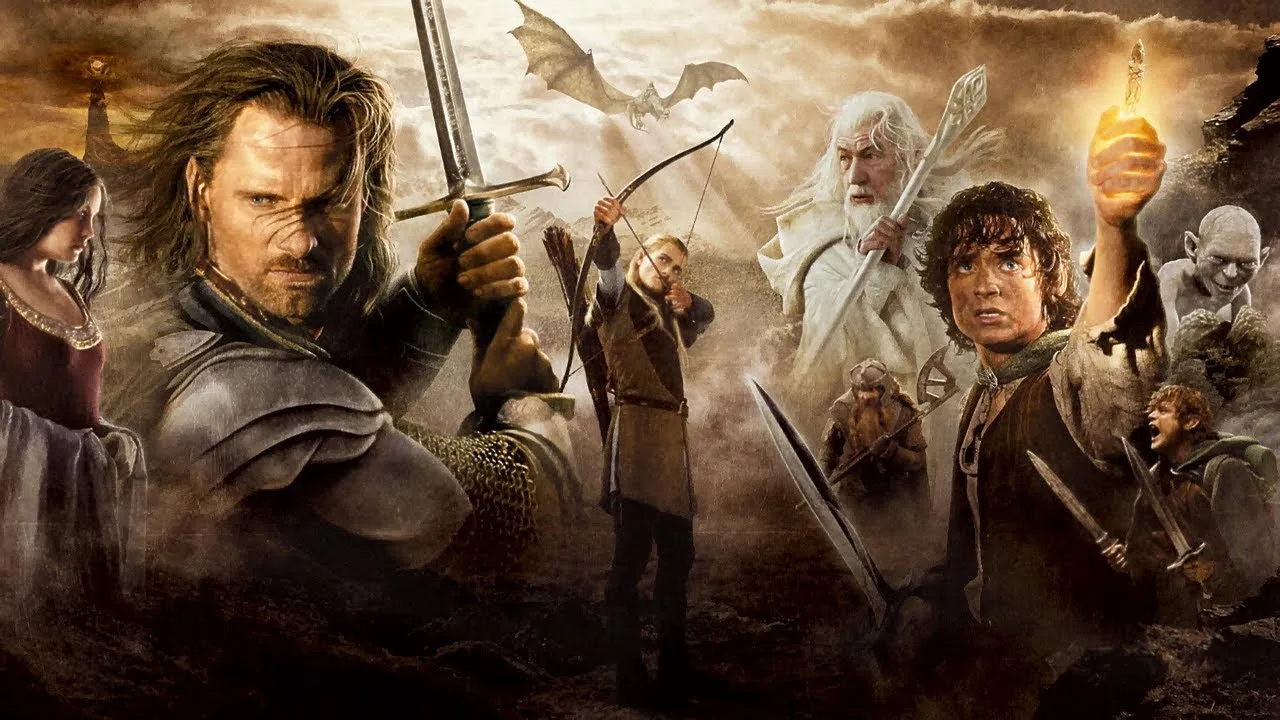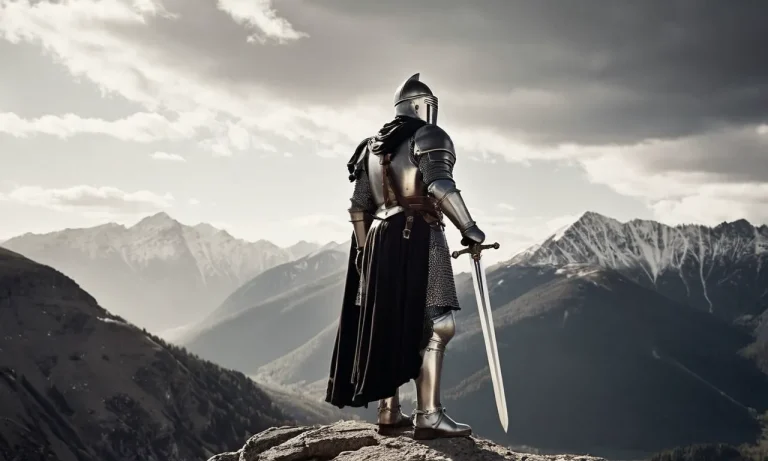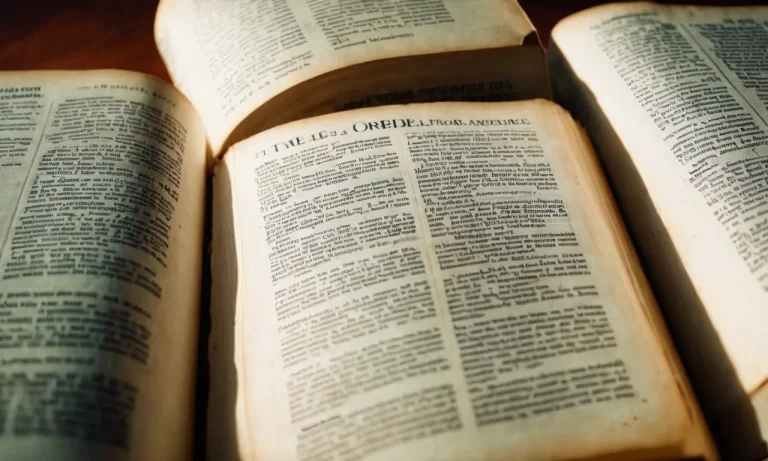Is The Lord Of The Rings A Christian Work?
J.R.R. Tolkien’s epic fantasy novel The Lord of the Rings is one of the most beloved and influential works of literature of all time. But ever since its publication in 1954-1955, there has been much debate among readers on whether the novel promotes Christian themes and values.
If you’re short on time, here’s a quick answer: While Tolkien rejected direct allegory, The Lord of the Rings does contain many Christian influences, themes, and symbols based on Tolkien’s strong Catholic faith.
In this approximately 3000 word article, we will examine the evidence on both sides of this debate by looking at Tolkien’s faith, his statements on the novel’s meaning, the use of Christian themes and imagery, character archetypes, and more.
Tolkien’s Christian Faith and Background
J.R.R. Tolkien, the beloved author of The Lord of the Rings trilogy, was deeply influenced by his Christian faith and upbringing. Born in 1892 in South Africa, Tolkien was raised in a devout Catholic family.
His faith played a significant role in shaping his worldview and ultimately influenced his writing.
Devout Catholic Upbringing
Tolkien’s devout Catholic upbringing had a profound impact on his life and work. He was educated at a Catholic school and regularly attended church with his family. The teachings of the Catholic Church, particularly its emphasis on morality and the battle between good and evil, would later manifest in his novels.
Tolkien’s experiences as a young boy attending Catholic Mass and participating in religious rituals provided him with a rich tapestry of symbolism and imagery that he would later incorporate into his stories.
The themes of sacrifice, redemption, and the struggle against temptation can be seen throughout The Lord of the Rings.
Relevance of Theology in His Works
Tolkien’s works are not overtly religious, but his Christian beliefs are woven into the fabric of his storytelling. He once described The Lord of the Rings as a “fundamentally religious and Catholic work,” although he also emphasized that it was not an allegory.
The moral and spiritual undertones in Tolkien’s novels reflect his belief in the power of good over evil and the importance of hope in the face of adversity. The characters in his stories often face internal and external battles that echo the struggles faced by individuals in the real world.
Through his writing, Tolkien sought to explore universal themes and truths that resonate with readers of all faiths.
Opinions on Christianity in Fantasy Literature
Tolkien had strong opinions on the role of Christianity in fantasy literature. He believed that Christian themes could be effectively conveyed through the medium of fantasy, as it allowed for imaginative exploration of spiritual truths.
In fact, he saw fantasy as a means of re-enchanting the world by reconnecting readers with the deeper realities of life.
Tolkien’s views were not universally accepted at the time, as some critics dismissed fantasy literature as mere escapism. However, his work has since been recognized for its profound depth and the way it addresses complex moral and philosophical questions.
The enduring popularity of The Lord of the Rings is a testament to its ability to resonate with readers of all backgrounds, including those of different faiths.
Christian Themes and Parallels
One of the most debated questions surrounding J.R.R. Tolkien’s The Lord of the Rings is whether it can be considered a Christian work. While Tolkien himself stated that it was not intended as an allegory, many readers have found numerous Christian themes and parallels within the story.
This article will explore some of these themes and discuss their significance in relation to Christianity.
Good vs. Evil Struggle
One of the central themes in The Lord of the Rings is the struggle between good and evil. This theme is deeply rooted in Christian theology, where the belief in the existence of evil and the need to combat it is fundamental.
The battle of the Fellowship against the forces of Sauron can be seen as a reflection of the Christian concept of spiritual warfare. The characters’ unwavering commitment to fighting evil, even in the face of great adversity, mirrors the Christian belief in the importance of resisting temptation and standing up for what is right.
Furthermore, the corrupting influence of power, as portrayed by the One Ring, can be interpreted as a representation of the Christian notion of sin and its ability to corrupt even the noblest of hearts.
The quest to destroy the Ring can be seen as a metaphor for the Christian journey towards redemption and the struggle to overcome the allure of sin.
Messianic Suggestions of Gandalf
Gandalf, the wise and powerful wizard, exhibits several messianic qualities throughout the story. His resurrection after his battle with the Balrog can be interpreted as a symbol of Christ’s resurrection.
Additionally, his role as a guide and protector of the Fellowship parallels Jesus’ role as the shepherd of his flock.
Gandalf’s sacrificial nature is also reminiscent of Christ’s selflessness. He willingly puts himself in harm’s way to ensure the success of the quest, just as Jesus sacrificed himself for the salvation of humanity. This selflessness is exemplified in Gandalf’s words, “I cannot do this alone.
I need you all.” This echoes Jesus’ call for unity and collaboration among his followers.
Frodo’s Christ-like Sacrifice
Perhaps the most prominent Christ-like figure in The Lord of the Rings is Frodo Baggins. His journey to Mount Doom to destroy the Ring can be seen as a parallel to Christ’s sacrifice on the cross. Frodo carries the burden of the Ring, symbolizing the weight of sin, and willingly endures great suffering and temptation for the greater good.
Just as Jesus willingly embraced his fate, Frodo accepts the heavy responsibility placed upon him, knowing that it may cost him his life. His selflessness, resilience, and unwavering determination serve as a powerful representation of Christ’s ultimate sacrifice for humanity.
Use of Christian Imagery and Symbolism
Heaven and Hell Archetypes
In The Lord of the Rings, author J.R.R. Tolkien incorporates Christian imagery and symbolism to explore themes of good versus evil. One prominent example is the portrayal of heaven and hell archetypes. The heavenly realm is represented by the Undying Lands, a place of eternal bliss and peace where the immortal elves reside.
On the other hand, the fiery realm of Mordor symbolizes hell, ruled by the dark lord Sauron. This juxtaposition of heavenly and hellish imagery reflects the Christian belief in a divine paradise and a place of eternal damnation.
Biblical Numbers and Prophetic Visions
Tolkien also incorporates biblical numbers and prophetic visions into his work. The number three, which holds significance in Christianity as representing the Holy Trinity, is recurring throughout the story.
For instance, there are three main characters in the Fellowship of the Ring: Frodo, Sam, and Gandalf. Additionally, the prophetic visions and dreams experienced by characters such as Frodo and Aragorn mirror biblical prophecies found in the book of Revelation.
These elements add depth to the narrative and provide a Christian undertone to the story.
Savior and Satanic Tropes
In The Lord of the Rings, there are several savior and satanic tropes that draw parallels to Christian mythology. Frodo, the ring-bearer, can be seen as a Christ-like figure who carries the burden of the One Ring to save Middle-earth from darkness.
Similarly, the character of Gollum represents a fallen being corrupted by evil, reminiscent of Satan in Christian theology. These tropes highlight the themes of redemption, sacrifice, and the battle between good and evil, which are central to Christianity.
It is important to note that while The Lord of the Rings incorporates Christian imagery and symbolism, Tolkien himself stated that the story is not an allegory for Christianity. Instead, he considered it a mythic tale that explores universal themes.
Nevertheless, the presence of Christian elements in the narrative adds depth and richness to the story, making it a thought-provoking work for readers of all backgrounds.
Tolkien’s Statements on Allegory Claims
Throughout his life and career, J.R.R. Tolkien consistently rejected the notion that his famous work, The Lord of the Rings, was a direct allegory for Christianity. While Tolkien was indeed a devout Catholic, he maintained that his intention was to create a mythic and fantastical world rather than to convey religious teachings through his writing.
Rejecting Direct Religious Parallels
Tolkien made it clear that he did not intend for The Lord of the Rings to be a direct allegory for Christianity or any specific religious belief. In a letter to a friend, he stated, “I have not put in, or have cut out, practically all references to anything like ‘religion’, to cults or practices, in the imaginary world.”
This statement highlights Tolkien’s desire to create a rich and immersive fictional universe that was separate from the religious beliefs of the real world.
Allowing Readers to Apply Meanings
Tolkien believed in the power of reader interpretation and emphasized that readers should be able to apply their own meanings to his work. He stated, “I cordially dislike allegory in all its manifestations, and always have done so since I grew old and wary enough to detect its presence.”
By rejecting allegory, Tolkien allowed readers to engage with his story on a personal level, finding their own connections and interpretations without being limited by a fixed religious message.
Sub-creation vs. Intentional Allegory
Tolkien distinguished between what he called “sub-creation” and intentional allegory. He described sub-creation as the act of creating a secondary world that operates under its own rules and has its own internal consistency.
In this context, The Lord of the Rings can be seen as a sub-creation that explores themes of good versus evil, friendship, and sacrifice, without directly mirroring religious teachings.
While Tolkien’s own faith undoubtedly influenced his writing, he made it clear that he did not want his work to be seen as a deliberate allegory. Instead, he intended for readers to experience the story on its own terms, allowing them to find personal meaning within the themes and characters he created.
Criticism and Counter-Arguments
Pagan and Multi-Faith Influences
One criticism of The Lord of the Rings as a Christian work is the presence of pagan and multi-faith influences throughout the story. Critics argue that Tolkien drew inspiration from various mythologies and religions, including Norse, Celtic, and Finnish folklore.
They point to the presence of creatures like elves, dwarves, and wizards, which have roots in pagan mythology.
However, it is important to note that Tolkien himself was a devout Catholic, and he believed that Christianity was the true myth that underpinned all other myths. He viewed his own work as a way to create a mythology for England that was consistent with his Christian beliefs.
While there are undoubtedly pagan influences in The Lord of the Rings, they are not meant to be seen as endorsements of those beliefs, but rather as part of a larger tapestry of world-building.
Tolkien’s Dislike of Explicit Allegory
Another argument against The Lord of the Rings being a Christian work is J.R.R. Tolkien’s own dislike of explicit allegory. Tolkien famously stated that he despised allegory in all its forms and that his work was not intended to be a direct allegory for any specific religious or political ideology.
Instead, Tolkien preferred the term “applicability,” which means that his stories can be read in different ways and applied to various situations. He believed that his work could resonate with readers regardless of their religious beliefs, and that it could convey universal themes of heroism, sacrifice, and the struggle between good and evil.
Secular Literary Interpretations
Some literary critics argue that The Lord of the Rings can be interpreted through a secular lens, with themes of environmentalism, political power struggles, and the consequences of war. They view the story as a reflection of Tolkien’s own experiences during World War I and his concerns about industrialization and the destruction of nature.
While these interpretations are valid and can add depth to our understanding of the novel, it is important not to overlook the Christian themes and symbolism that are woven throughout the narrative. Tolkien himself stated that his Catholic faith influenced his writing, and there are numerous instances of Christian imagery and messages in the text.
From the sacrificial acts of characters like Frodo and Gandalf to the overarching theme of redemption, The Lord of the Rings cannot be fully understood without considering its Christian undertones.
Conclusion
In conclusion, while Tolkien rejected direct allegory between his novels and Christianity, The Lord of the Rings undoubtedly contains many Christian themes, symbols, and values that stem from Tolkien’s own faith.
However, the novel remains open to varied interpretation, allowing readers to apply both religious and secular meanings to the text.








